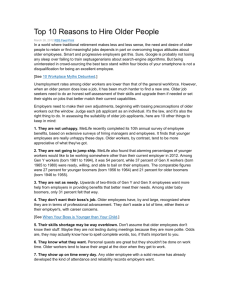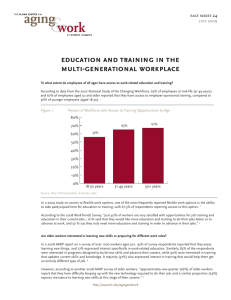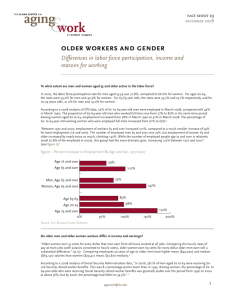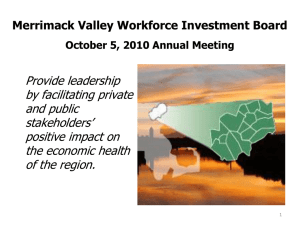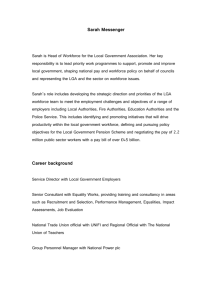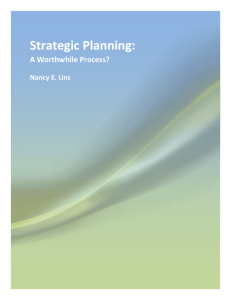business strategies for the age-diverse workforce
advertisement
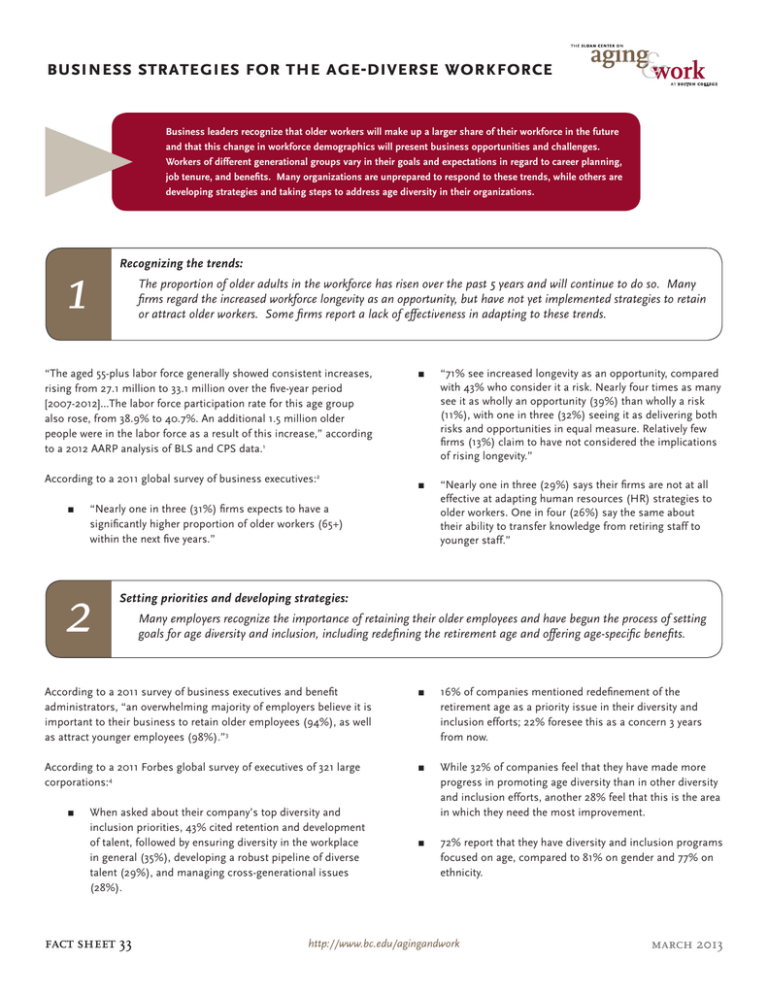
business strategies for the age-diverse workforce Business leaders recognize that older workers will make up a larger share of their workforce in the future and that this change in workforce demographics will present business opportunities and challenges. Workers of different generational groups vary in their goals and expectations in regard to career planning, job tenure, and benefits. Many organizations are unprepared to respond to these trends, while others are developing strategies and taking steps to address age diversity in their organizations. Recognizing the trends: 1 The proportion of older adults in the workforce has risen over the past 5 years and will continue to do so. Many firms regard the increased workforce longevity as an opportunity, but have not yet implemented strategies to retain or attract older workers. Some firms report a lack of effectiveness in adapting to these trends. “The aged 55-plus labor force generally showed consistent increases, rising from 27.1 million to 33.1 million over the five-year period [2007-2012]…The labor force participation rate for this age group also rose, from 38.9% to 40.7%. An additional 1.5 million older people were in the labor force as a result of this increase,” according to a 2012 AARP analysis of BLS and CPS data.1 According to a 2011 global survey of business executives:2 ππ ππ “71% see increased longevity as an opportunity, compared with 43% who consider it a risk. Nearly four times as many see it as wholly an opportunity (39%) than wholly a risk (11%), with one in three (32%) seeing it as delivering both risks and opportunities in equal measure. Relatively few firms (13%) claim to have not considered the implications of rising longevity.” ππ “Nearly one in three (29%) says their firms are not at all effective at adapting human resources (HR) strategies to older workers. One in four (26%) say the same about their ability to transfer knowledge from retiring staff to younger staff.” “Nearly one in three (31%) firms expects to have a significantly higher proportion of older workers (65+) within the next five years.” 2 Setting priorities and developing strategies: Many employers recognize the importance of retaining their older employees and have begun the process of setting goals for age diversity and inclusion, including redefining the retirement age and offering age-specific benefits. According to a 2011 survey of business executives and benefit administrators, “an overwhelming majority of employers believe it is important to their business to retain older employees (94%), as well as attract younger employees (98%).”3 ππ 16% of companies mentioned redefinement of the retirement age as a priority issue in their diversity and inclusion efforts; 22% foresee this as a concern 3 years from now. According to a 2011 Forbes global survey of executives of 321 large corporations:4 ππ While 32% of companies feel that they have made more progress in promoting age diversity than in other diversity and inclusion efforts, another 28% feel that this is the area in which they need the most improvement. ππ 72% report that they have diversity and inclusion programs focused on age, compared to 81% on gender and 77% on ethnicity. ππ When asked about their company’s top diversity and inclusion priorities, 43% cited retention and development of talent, followed by ensuring diversity in the workplace in general (35%), developing a robust pipeline of diverse talent (29%), and managing cross-generational issues (28%). fact1 sheet 33 http://www.bc.edu/agingandwork march 2013 According to a 2012 Metlife report:5 ππ 3 ππ “73% of employees say that they value more personalized benefits geared to employee age groups, while 53% of employers report that they are likely to offer benefits geared to employee age groups in the next 5 years.” Taking action steps: Many companies report that they already have age-diversity programs in place. Others report specific steps that are being planned for encouraging older workers to remain in their workforces. Such steps include offering flexible employment options, education and development opportunities, and knowledge transfer programs. Among steps that employers plan to take to mitigate the potential loss of knowledge as older workers retire, “more than half of the employers say that they will try to keep older workers on as parttime workers or consultants (69%), they will use a knowledge transfer program to allow workers who are approaching retirement age to mentor or transfer knowledge to younger workers (53 %), and they will use a succession plan for critical positions (51 %).” Almost half (46 %) will try to entice older workers to remain as full-time employees,” according to a 2011 AARP survey of over 1000 HR directors.6 ππ 50% of employers report that they are offering flexible or customized work schedules to retain older employees, while 45% report that they offer such schedules to attract younger employees. ππ Employers are taking “steps to retain older employees, including offering education around retirement income and health care (33%), as well as providing extended benefits (21%).” Many small business owners report that they “already offer, or are agreeable to implementing, a number of workplace adjustments attractive to older workers, including: part-time employment (65%); specific project work (43%), contract or consulting work (35%), working from home (25%) and job sharing (23%),” according to a 2012 survey of small business owners in Canada.7 According to a 2011 survey of business executives and benefit administrators:3 ππ “59% of employers are considering generational differences and needs in their strategic thinking about benefits.” That is, they agree with the statement “our company strives to understand and meet our employees’ different generational needs when it comes to benefits products, programs, and services.” 53% of employers report that they are offering continuing education and development to attract younger employees, while 32% report offering such programs to help retain older employees. References 1 Rix, S. (2013). The employment situation, December 2012: Five years after the start of the great recession. (Fact Sheet No. 276). Washington, DC: AARP Public Policy Institute. Retrieved from http://www.aarp.org/content/dam/aarp/research/ public_policy_institute/econ_sec/2013/the-employment-situation-december2012-AARP-ppi-econ-sec.pdf 2 3 Economist Intelligence Unit. (2011). A silver opportunity? Rising longevity and its implications for business. Geneva: Economist Intelligence Unit Limited. Retrieved from http://viewswire.eiu.com/report_dl.asp?mode=fi&fi=1877919572.PDF Bank of America Merrill Lynch workplace benefits report. (2011). USA: Bank of America. Retrieved from http://www.benefitplans.baml.com/Publish/Content/ application/pdf/GWMOL/Executive-Summary-BofAML-Workplace-BenefitsReport.pdf 2 4 5 Forbes. (2011). Fostering innovation through a diverse workforce. New York, NY: Forbes Insight. Retrieved from http://images.forbes.com/forbesinsights/StudyPDFs/Innovation_Through_Diversity.pdf Metlife. (2012). 10th Annual study of employee benefits trends: Seeing opportunity in shifting tides. New York: Metlife. Retrieved from https://www.metlife.com/assets/ institutional/services/insights-and-tools/ebts/ml-10-Annual-EBTS.pdf 6 7 Perron, R. (2011). Employer experiences and expectations: Finding, training, and keeping qualified workers. Washington, DC: AARP. Retrieved from http://assets. aarp.org/rgcenter/econ/finding-training-keeping-qualified-workers.pdf Investors Group. (2012). A little bit older, A little bit wiser: Canada’s small business owners admire older workers. Winnepeg, Canada: Investors Group. Retrieved from http://www.investorsgroup.com/en/client-resources/investors-groupnews/a-little-bit-older-a-little-bit-wiser Study.pdf http://www.bc.edu/agingandwork
